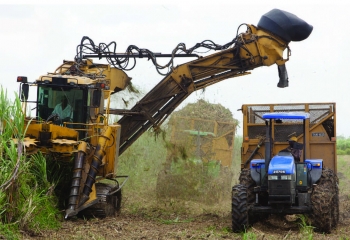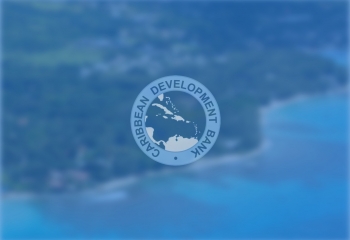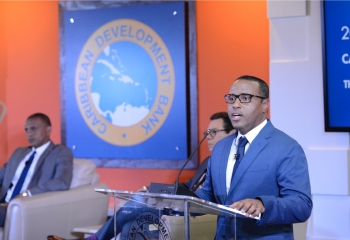Building Forward to Create a Resilient Future
Preamble
It is an honour and a privilege to deliver the keynote address at this banquet and awards ceremony marking the 70th Anniversary of the Incorporated Master Builders Association of Jamaica. I take the opportunity to congratulate all the members of the Association for this stellar achievement. I congratulate your partners, allies, well-wishers, and supporters, because as the leader of a regional institution, I am aware that there are many individuals and organisations that would have supported your work – tacitly and directly – over the last seven decades. Let me also recognise the contribution of members who would have paved the way from the early years of the Association, and who are no longer with us. No doubt, as construction professionals you would understand that we must acknowledge all building endeavors follow from the foundations established by those who came before us. Let us therefore salute these foundation builders!
Let me also say how good it feels to be in Jamaica, a place I can describe as home! It warms my heart to see familiar faces but also to meet new colleagues as all of us continue to be involved in the mission of enabling this nation to reach its full potential.
This evening, as we take this opportunity to pause and celebrate the successes and achievements of the last 70 years, I want to challenge us to ponder the next 70 years, the next generation of nation builders..…and ask what will they look like? I suggest we have to create the future we want. You may ask, what exactly does that mean?
Let me summarise some background context for my remarks, given the theme of Building Forward to Create a Resilient Future. Attaining sustainable development requires a holistic ecosystem approach, given the multi-faceted linkages that exist in promoting sustainable livelihoods. For that holistic development to occur, it must be based on resilience of the entire ecosystem, which means equally a multidimensional interlinked resilience ecosystem. The internal resilience capacity (IRC) of the country, which reflects the resilience ecosystem, should be the central glue for: (i) the measurement used to define our long-term goals; (ii) the effective prioritisation of investment activities; (iii) the more equitable allocation of financing resources; and (iv) the strengthening of implementation capacity. This makes the IRC the central hub linking the multidimensional aspects of development, essentially augmenting, or replacing Gross National Income (GNI) as the predominant measure of development progress. Underpinning this concept is the fundamental notion that key (backbone) national and regional goals need - 2 - to be promoted, with clarity on how they potentially can address the development challenges we face. They could also be viewed as: (i) minimising policy uncertainty that can arise from our democratic ideals; and (ii) fostering partnerships between the public and private sectors to forge complementarity of purpose in achieving the national goals – in essence, promoting a partnership for prosperity and profits (prosperity of the people and profits for investors).
A Lesson from History
I will start by drawing from recent history. In 2011, the Tohoku region in Japan experienced a 9.0 magnitude earthquake. It was the most powerful temblor ever recorded in that country and triggered a tsunami that resulted in the costliest natural disaster in history – an economic cost of approximately USD 235 billion. Given the country’s location along the infamous “Pacific Ring of Fire”, there was no telling when the next seismic shock would occur. Consequently, Japan refined its already extensive Building Standards to address this ever-present threat. All modern structures, from residential homes to high-rise buildings, are engineered to strict building codes and even small or temporary structures must be resilient to seismic events. Today, Japan is at the forefront of earthquake-resistant construction. May I invite you to consider for a moment building that type of resilience in all aspects of our development ecosystem!
Here at home in Jamaica, the situation in Japan may be unnervingly familiar to those of you who lived through Hurricane Gilbert in 1988. The impact of that event was still etched in people’s memory decades later because even when I lived in Jamaica, some 20 years after, people still referred to lie before, during, and after Gilbert. The devastation wreaked by that storm was a hard lesson for the local construction fraternity – indeed for the members of the IMAJ. Many seasoned professionals realised that their work did not withstand the ultimate test. However, in the ensuing years, their exam results improved significantly during the likes of hurricanes Ivan, Dean, and Gustave. Why? Because as a fraternity, you learnt that your structures had to be able to withstand the powerful forces of man and nature. Simply put, you had to build resilient structures.
Fast forward to 2023 and the landscape is more troubling than ever because we live in a hurricaneprone Region, which is vulnerable to seismic events, affected by volcanic threats, floods, landslide and droughts, and subject to the unfathomable impact of climate change. According to the Global Facility for Disaster Reduction and Recovery, Jamaica is the third most exposed country in the world to multiple hazards, with over 96 percent of the country’s Gross Domestic Product (GDP) and population at risk from two or more hazards1 . May I interject, maybe among countries with the greatest need for adequate resilience capacity to multiple hazards. Between 1980 and 2021, the island was impacted by 14 named storm-events and numerous flood and drought events. The situation is particularly precarious when we consider that an estimated 90% of Jamaica’s GDP is earned within the coastal zones, from Tourism and other leading sectors2 . In addition, much of the island’s critical infrastructure is also located within coastal zones, making the country highly susceptible to the onset of coastal hazards and prone to significant costs arising from them. This is not a comforting situation, particularly when we consider that climate hazards are projected to continue and worsen3 . The combination of exposure and sensitivity to natural hazards and the effects and costs of climate change make it imperative for us to strengthen the capacity of our industries, institutions, and infrastructure to withstand potential disruptors. I suggest that the most efficient means of achieving this objective is by building resilience to these stressors and reducing vulnerability to their impacts. Simply put – we must build with the future in mind – such that the next 70 years are characterised by less damage and quicker recovery. We can’t predict the shocks, but we can and must prepare for them – this is the frontier on which you in the construction sector exist.
What exactly do we mean when we refer to resiliency in infrastructure? Definitionally, resiliency is about reducing risk, enhancing reliability, and maintaining operational continuity in the face of all shocks and stressors an asset or system may face over its purposeful life. Operationally, it involves the planning, design, and construction of infrastructure to minimise service costs while being able to reduce the magnitude and duration of disruptive events. Resiliency in infrastructure is also the merging of knowledge and innovation to engineer and construct our roads and bridges to withstand the test of time, elements, and mother nature. The speed of a country’s recovery from a natural disaster event, for example, will depend on how quickly access of goods and supplies can reach affected areas, on the time to restore the maintenance of power, telecommunications, and water and sanitation to households, and to the provision of public facilities to hospitals, schools, police stations, and public administrative offices. While the foregoing suggests a focus on the rate at which a system returns to a predefined state, following a disturbance, the intersecting development space is more complex, since resilience considerations need also to incorporate sustainability. Therefore, even as we build today to withstand the shocks of tomorrow, we must build today in such a way that what we build does not compromise the welfare of the users of tomorrow – in fact, it should contribute to the sustainable livelihoods of tomorrow.
To look at another dimension, what does building forward for resilience and sustainability look like in energy? As we all know energy is a vital input in all economic activity and, as former United Nations Secretary-General, Ban Ki-Moon, put it energy is the “golden thread that connects economic growth, social equity, and environmental sustainability”. Sustainable energy, therefore, must be at the centre of building a resilient and sustainable ecosystem. The blueprint for sustainable energy as outlined in the 2030 Sustainable Development Goals includes: (i) ensuring universal access to affordable, reliable, sustainable, and modern energy services; (ii) increasing substantially the share of renewable energy in our energy mix; (iii) doubling the rate of improvement in energy efficiency; (iv) enhancing international cooperation to facilitate access to clean energy research and technology; and (v) expanding infrastructure and upgrading technology. In pursuit of this, CARICOM has set a target 47% renewable energy contribution to total electricity generation by 2027 - a target that remains elusive. According to the International Energy Agency, building operations globally accounted in 2021 for 30% of world final energy consumption and 27% of total energy sector emissions. Given the abundance of solar energy and our comfort with solar PV and battery energy storage technologies, shouldn’t every single new building (residential or commercial) in the Caribbean have solar and other renewable energy options integrated in its construction? Why can’t all roofs be designed to be Cat 5-hurricane resilient? Why can’t foundations be on cement structures that can absorb and store carbon? Equally, can we not think of adopting (or adapting) innovative approaches for use in ventilation and lighting to have our buildings use less energy while also maximising energy efficiency features?
The opportunities are not just confined to buildings. There are now real and credible opportunities to develop energy saving highways! Through the development of so-called climate asphalt and its lower rolling resistance (that experienced as vehicles rollover the surface), we can achieve lower fuel consumption, lower particle emissions, and possibly lower noise emissions. One study showed that 4% reduction in rolling resistance in Denmark would provide yearly reductions of 60 million litres of fuel, equal to 140,000 tonnes of CO2. There is also exciting work being done by Cornell University on the design of wireless charging roads! In a simulation study, they developed a transportation–power system framework that could incorporate a wireless charging road system into the real-time electricity market, and proposed an optimisation-based control strategy that could operate the energy storage system in a costefficient manner.
My friends, welcome to the imagination of our new tomorrow. In my view, these examples are just the tip of the iceberg for what is possible, and indeed how we can create the future we want. But as exciting as the foregoing is we cannot escape the fact that innovation and access to adequate and affordable financing are at the heart of it all. Let me be provocative. Why shouldn't our learning systems be focused on inquiry, discovery, and problem solving, span kindergarten to retirement and beyond, highlight the primacy of our innate intellectual might, and promote the potential of making the Region a hub for world class innovation? And why can’t the novelty and aspiration of our vision be attractive enough to local, regional, and international investors? Why can’t we re-imagine future-proof and futuristic policy environments that can engage the most entrepreneurial of us to embrace a preference for long-term adequate and sustainable returns versus short-term, super-normal returns with a shelf life that discounts a sustainable future?
Given the above questions, I am sure the burning question for you is who pays for it? Let me begin by establishing that investing in resilience should not necessarily be about spending more - sometimes it’s a matter of spending better and other times it’s a matter of measuring better the impact of the spending. A 2019 World Bank report4 highlighted that the net benefits of investing in resilient infrastructure in low- and middle-income countries could be as much as $4.2 trillion US dollars, over the lifetime of new infrastructure. The net benefit of building more resilient infrastructure in low- and medium-income countries would be $4 dollars for every dollar invested. Therefore, what we need is more extensive data and stronger analytics to inform evidenced-based decision-making for better returns on infrastructure investment. Coupled with this, there must be more optimal interplay between the Government and the Private Sector. You may have heard that CDB has been calling for and is prepared to facilitate greater Private Sector involvement in Sustainable Development. Let me add immediately that we cannot achieve the most advantageous outcomes from public/private collaboration with our current approach to PublicPrivate-Partnerships (PPPs). In much the same way that, as part of your 70th anniversary celebrations, you are reflecting on the fact that your subject disciplines as practiced today have evolved considerably from that practiced by the founders and pioneers of this Association, we need to ask whether the existing concept of Public Private Partnership is optimally fit for purpose to address the challenges of today and the future. My proposal, which some of you have probably heard before, is for PPPs to be re-imagined as Partnerships for Prosperity and Profits, underpinned by low policy uncertainty environments and national anchorobjectives that form the foundational backbone for delivery of sustainable, development outcomes.
Success Story – Jamaica’s Energy Industry
Let me highlight a narrative on energy. Indeed, if you need a success story look no further than your energy industry, where Jamaica has been a trailblazer in energy transformation. The Government of Jamaica’s 2009 National Energy Policy stipulated that renewable sources would account for 20% of the energy supplied to the grid by 2030. In the ensuing years, four wind energy generation plants, two solar farms, and one hydro plant - all at utility-scale level, have been commissioned. Three new players entered the renewable energy market through an open, transparent, and competitive public auction process; and the hitherto government-owned wind power firm tripled its generating capacity and was divested via IPO, bringing thousands of Jamaicans into the local stock market, while providing part-ownership of a renewable energy enterprise. At the same time, hundreds of temporary and permanent jobs were created during the construction and operating phases of the seven new plants. Consequently, today Jamaica is trending in the right direction with approximately 18% renewable energy grid penetration. So, if the question is who pays for it, this example illustrates that when you combine the right policy approach from government with the appropriate propositions from the private sector, it can literally pay for itself.
My friends, this is low-hanging fruit that could transform the energy landscape and trigger a range of benefits to the entire economy and specifically the construction sector. CDB stands ready to support all the actors in implementing such a strategy.
The Built Environment and the Sustainable Energy Transition
My segue to energy underscores the fact that resilience encompasses numerous areas and sectors critical for lives and livelihoods, but the members of this Association are at the bedrock because your skills and services provide the structures that house, convey, enable, and facilitate the multiple facets of life as we know it.
As we work to renew and expand the infrastructure stock to meet the needs of tomorrow, we must embrace the opportunity to reduce our current high level of vulnerability through enabling and building better infrastructure, and members of the Incorporated Master Builders Association of Jamaica are uniquely placed to deliver that future-ready infrastructure for the people of Jamaica.
A Word of Caution
Although the context of my address is to this local audience, please allow me to make a point which could be relevant to all CDB’s Borrowing Member Countries. I have consistently argued that we must view resilience in a holistic manner. Therefore, as we seek to build resilient institutions, systems, buildings, and infrastructure, we must not overlook the critical importance of resilient human capital. This includes strengthening service delivery as well as ensuring relevant institutions and industries have robust and sustained national or regional human capacity in engineering, planning, architecture, and other expertise and relevant skills. This means that the country’s investment framework ought to encourage adequate local content and participation by local firms, professionals, and other actors, providing a basis for capacity building while attracting our young innovators to the sector. If we are proactive and intentional, we can amplify the benefits of external participation through simultaneously building resilience capacity.
Conclusion
In closing, permit me to revisit my opening historical vignette. The 2011 earthquake, one of the worst since the measurement of seismic activity began in 1900, resulted in Japan having some of the most resilient structures in the world. Should we wait for the worst natural hazard in history to galvanise us into action? And if we did wait, what will future generations say of us? My friends, the ability to adapt for a resilient future has a direct causal relationship with our survival and one thing is clear, we cannot create the future unless we are willing to challenge ourselves. Resilient infrastructure is one weapon of response to the increasing threat that natural hazards, climate change, and environmental degradation pose to our economies and societies. Extraordinary problems demand extraordinary solutions. Let us go forward boldly and purposefully. Thank you


